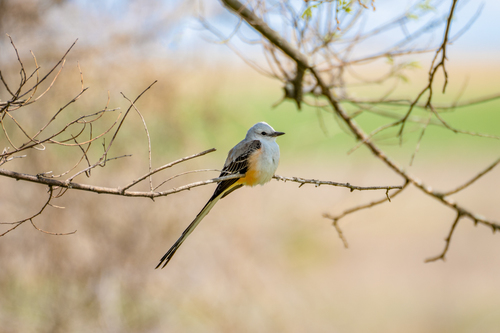
Scissor-tailed Flycatcher
The Scissor-tailed Flycatcher (*Tyrannus forficatus*) is a striking bird species renowned for its extraordinarily long, forked tail, which can be twice the length of its body. This New World tyrant flycatcher is an iconic sight in the south-central United States and parts of Mexico, where it graces open grasslands and savannas. Beyond its distinctive appearance, the Scissor-tailed Flycatcher plays a vital role in its ecosystem by controlling insect populations. It holds cultural significance in some regions, often seen as a symbol of grace and freedom.
25-38 cm
Length
35-40 cm
Wingspan
Least Concern
Conservation Status
Distribution
Breeds primarily in the south-central United States, including Texas, Oklahoma, Kansas, Louisiana, Arkansas, Missouri, and New Mexico. Migrates through Central America and winters in southern Mexico and Central America, with some individuals reaching as far south as Panama. Rarely, vagrants are seen in other parts of North America.
Lifespan
Typically 4-5 years in the wild, but some individuals have been recorded living up to 8 years.
Scissor-tailed Flycatcher's Habitat
Habitat Types
Open grasslands, Savannas, Pastures, Agricultural fields with scattered trees, Roadsides
Climate Zones
Temperate, Subtropical
Adaptations
Their long tail feathers, while seemingly cumbersome, aid in aerial maneuverability, allowing them to make sharp turns and twists while pursuing insects in flight. They prefer open habitats with perches like fence posts or utility wires for hunting.
Variations
No recognized subspecies.
Appearance
Breeding Plumage
Breeding plumage is more vibrant, with a more pronounced salmon-pink wash on the flanks and belly. Non-breeding plumage is slightly duller.
Seasonal Feather Changes
The tail feathers may become worn or broken during the breeding season and are replaced during molting.
Sex Based Plumage Differences
Males have significantly longer tail feathers than females. Juveniles have shorter tails and less vibrant coloration.
Notable Features
Extremely long, forked tail (especially in males), Pale gray head and back, Black wings and tail, Salmon-pink flanks and belly, White underparts
Diet and Feeding
Primary Foods
Insects (grasshoppers, crickets, beetles, wasps, flies), Spiders, Occasionally small fruits and berries
Foraging Behavior
Typically hunts from a perch, sallying out to catch insects in mid-air. Also hovers and gleans insects from foliage. Will occasionally forage on the ground.
Specializations
Exceptional aerial agility, aided by their long tail, allows them to capture flying insects with precision.
Seasonal Diet Variations
Diet primarily consists of insects during the breeding season. May consume more fruits and berries during migration and in wintering grounds when insects are less abundant.
Behavior
Social Structure
Generally solitary or found in pairs during the breeding season. Forms large flocks during migration and on wintering grounds.
Communication
A variety of chattering and buzzing calls, Visual displays using their long tail feathers, A rapid *kip* call is often given.
Migration
A long-distance migrant, traveling between breeding grounds in the south-central US and wintering grounds in southern Mexico and Central America. They often migrate in large flocks, following river valleys and coastlines.
Territorial or Group Behaviors
Males are territorial during the breeding season, defending their nesting area from other males. Outside of the breeding season, they are highly social.
Conservation
Threats
Habitat loss due to agriculture and urbanization, Pesticide use, which reduces insect prey populations, Collisions with vehicles and structures
Protection Programs
Conservation of grasslands and open habitats, Efforts to reduce pesticide use in agricultural areas, Migratory Bird Treaty Act
Local National Laws
Protected under the Migratory Bird Treaty Act in the United States.
Population Trend
Stable
Population Estimates
Global population estimated to be around 9.8 million individuals.
Interesting Facts
The Scissor-tailed Flycatcher is the state bird of Oklahoma.
It was chosen for its beauty and distinctive appearance.
Their scientific name, *Tyrannus forficatus*, means 'tyrant' (referring to the flycatcher family) and 'scissor-shaped' (referring to the tail).
This accurately describes their behavior and most notable feature.
The long tail feathers of the male can sometimes break off.
This can happen during fights with other males or during encounters with predators. The feathers will grow back during the next molt.
Flocks of Scissor-tailed Flycatchers can number in the hundreds or even thousands during migration.
These large flocks are an impressive sight.
Faqs about Scissor-tailed Flycatcher
What is the purpose of the Scissor-tailed Flycatcher's long tail?
The long tail is used for aerial maneuverability, allowing the bird to make sharp turns and twists while pursuing insects in flight. It also plays a role in courtship displays.
Where can I see a Scissor-tailed Flycatcher?
Look for them in open grasslands, savannas, and agricultural fields in the south-central United States during the breeding season. They can often be seen perched on fences, wires, or trees.
Are Scissor-tailed Flycatchers endangered?
No, they are currently listed as a species of Least Concern by the IUCN. However, their populations are facing some threats, such as habitat loss and pesticide use.
Do Scissor-tailed Flycatchers visit bird feeders?
Scissor-tailed Flycatchers primarily eat insects, and so they are not typically attracted to bird feeders that offer seeds or nuts. However, they may occasionally visit a bird bath for water.
Copyright @ Nature Style Limited. All Rights Reserved.
 English
English